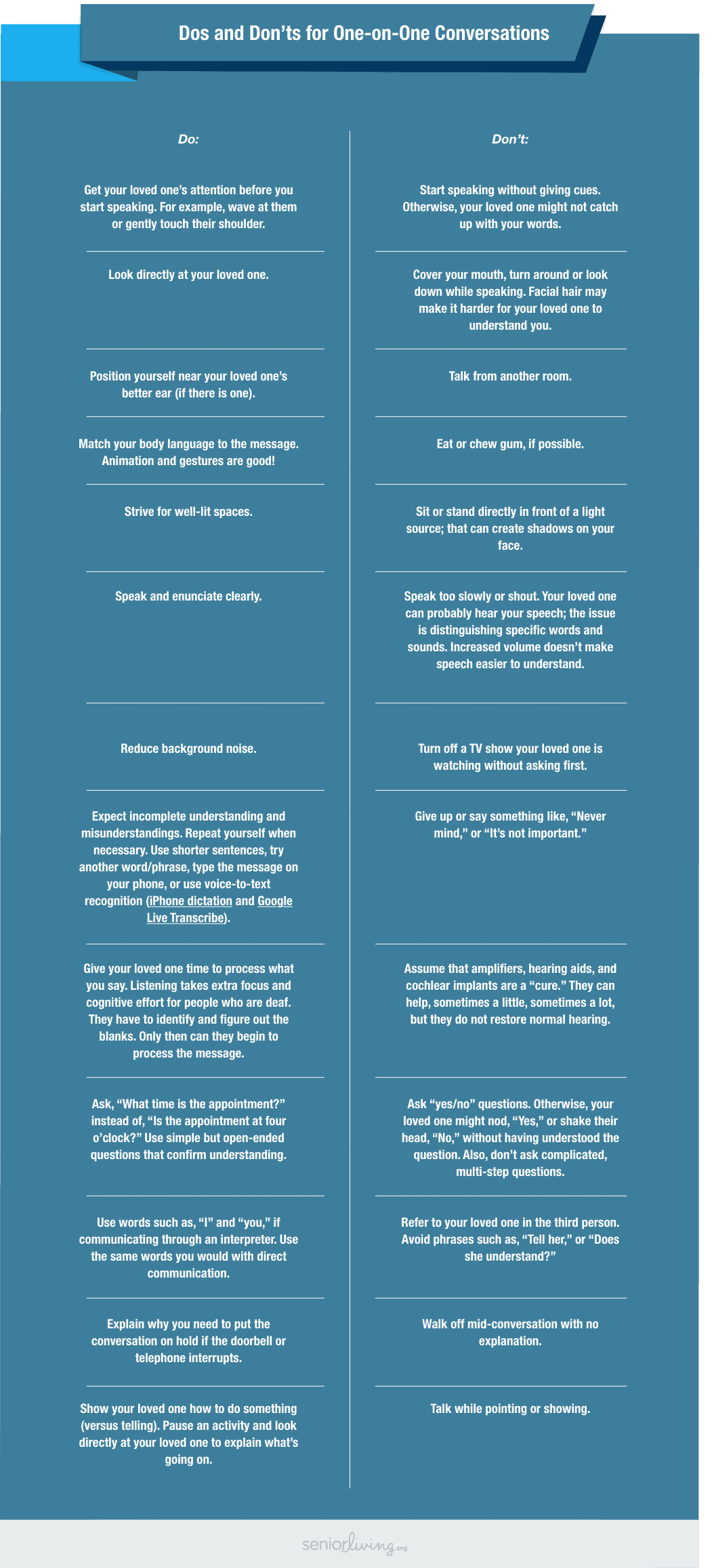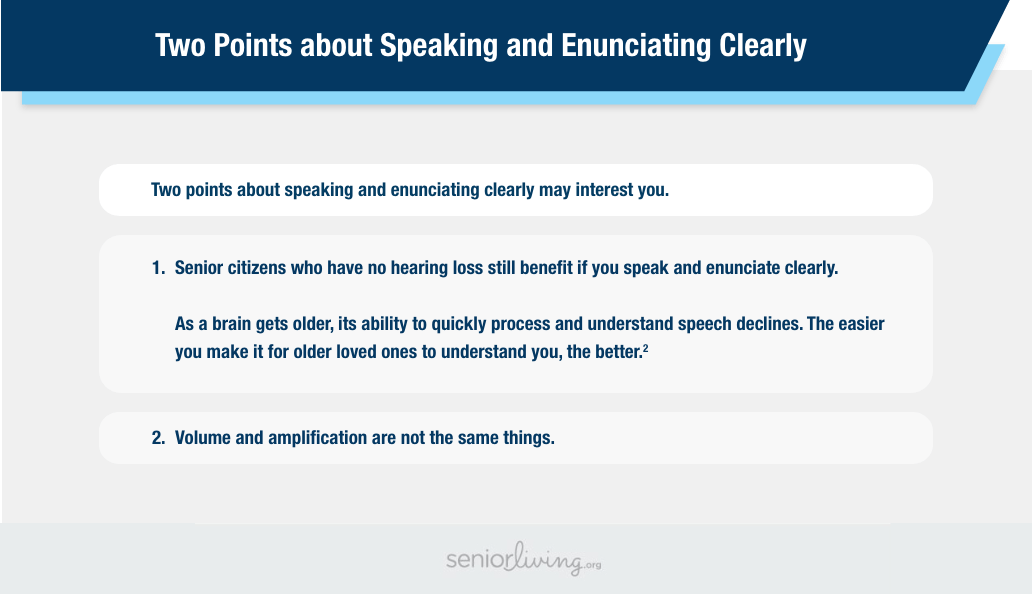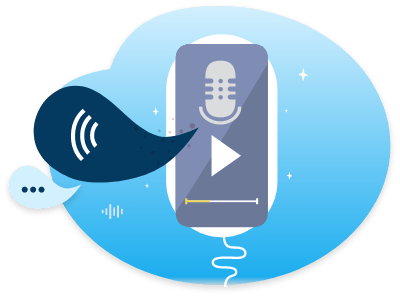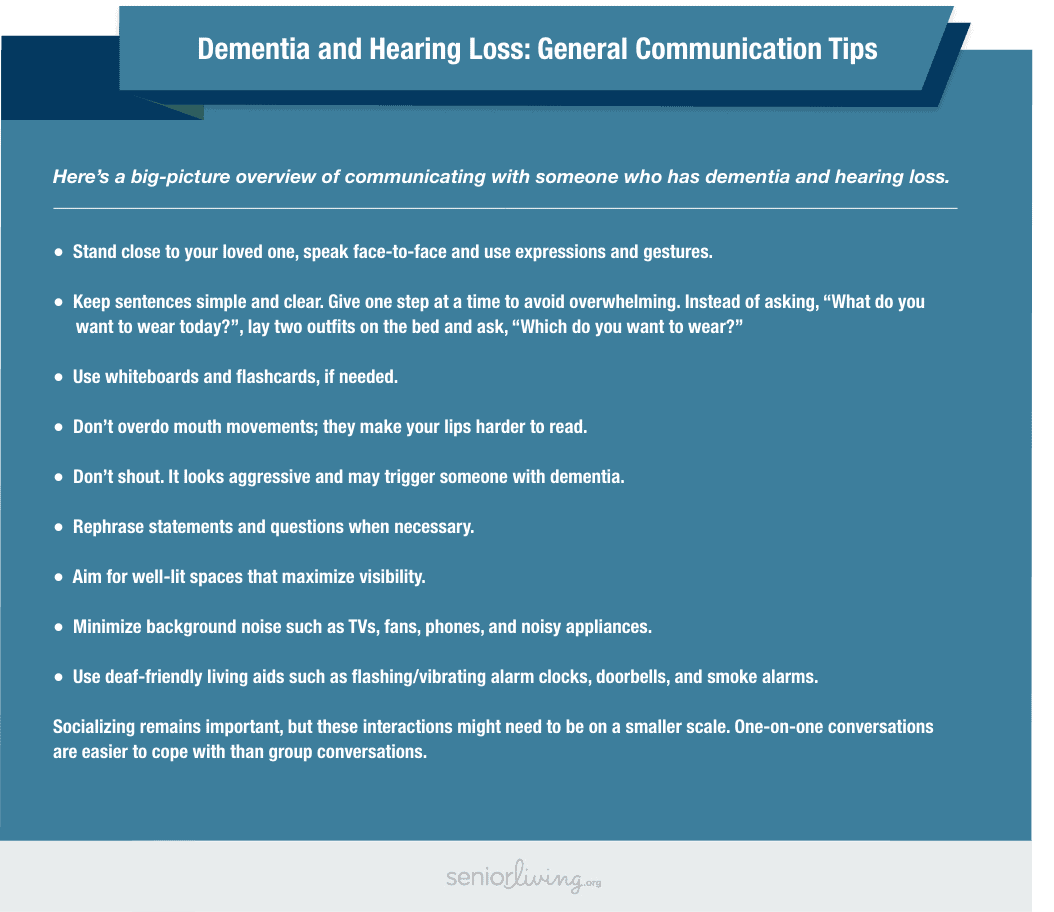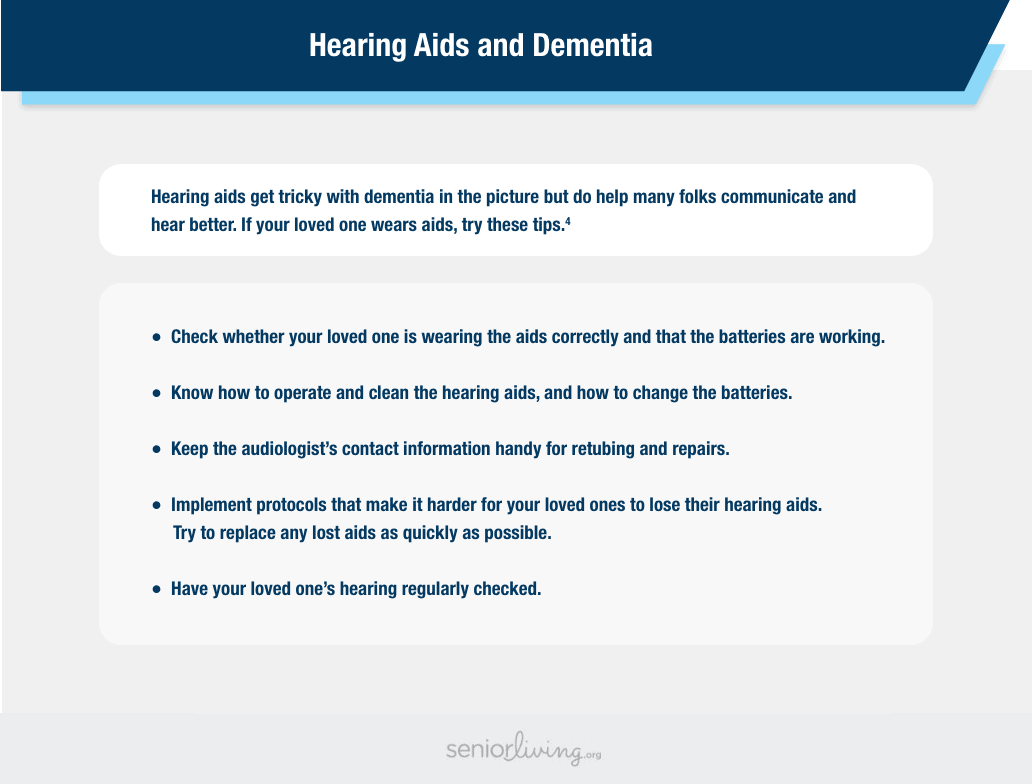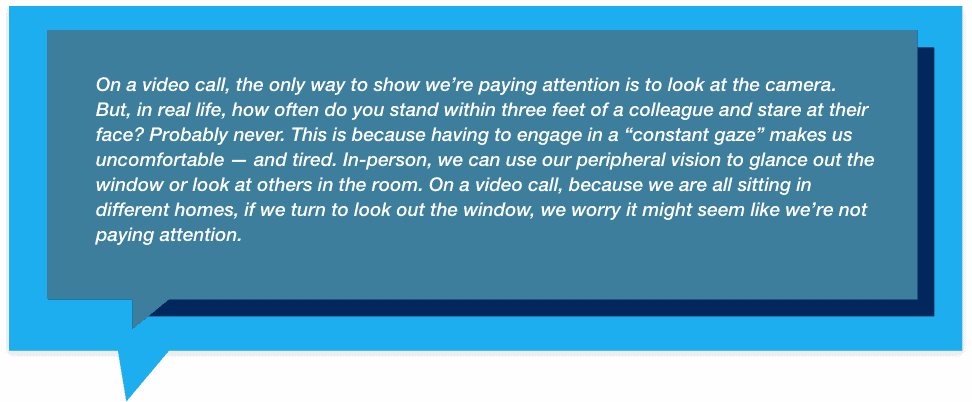Communicating with Seniors Who Are Deaf or Hard of Hearing:
Technology Tips, Best Practices, and Safety Devices
By Kelly Short, Master of Science in Deaf Education
Helen Keller had a point when she said, “Blindness cuts us off from things, but deafness cuts us off from people.” Even mild hearing loss can be isolating.
Fortunately, there's a lot you can do to ensure good communication between yourself and your loved ones with hearing loss. This guide covers topics such as one-on-one conversations, group conversations, and major events such as weddings. It also discusses communication when someone has hearing loss and dementia. First, a quick note before we dive into the guide: It uses “deaf” as the umbrella term for all types of hearing loss.
Table of Contents
- Severity of Hearing Loss Doesn't Necessarily Translate to Ease of Communication
- One-on-One Conversations
- Group Conversations
- Weddings, Birthday Parties, and Other Big Events
- Telephone Conversations
- Dementia and Hearing Loss
- Communication Through Interpreters
- Brain Breaks
- Safety Devices and Daily Living Aids for Hearing Loss
- Additional Resources
- References and Footnotes
Severity of Hearing Loss Doesn't Necessarily Translate to Ease of Communication
Mild hearing loss doesn’t always mean easier communication. It can mean harder communication if family members’ expectations are higher. For example, they might think, “My loved one can still hear well. I don’t need to do anything differently.”
Likewise, it’s easy to assume that hearing aids and cochlear implants are cures, but they are not. That’s especially true in group conversations and places where a lot of background noise is present.
Each person and situation is unique. The best way to figure out communication is to take a teamwork approach. Ask your loved ones how they want to communicate. What’s the easiest or most effective way? If your loved one’s hearing loss is new and scary to them, they might not yet know how they best communicate. That’s OK. This guide has many suggestions.
One-on-One Conversations
The table below explains the dos and don’ts of one-on-one conversations. In your particular situation, some tips are likely to apply more than others.1
Double-Communicate Important Information
Another tip is to send relevant information before or after a conversation. Suppose you're meeting your father for breakfast to tell him about a doctor’s appointment you made for him. Send him the details before or after the conversation. The double layer of confirmation ensures that nothing slips through the cracks.
Your email, text, or note can be simple. This type of email does just fine: “Hey, Dad, I made that appointment you wanted with Dr. Broomfield. It’s next Tuesday, 6/28, at 4 p.m. We’ll discuss more at breakfast.”
Remember that people who are deaf need time to understand and process what’s said to them. It’s not realistic to rattle off appointment dates and times and expect them to be 100 percent remembered each time.
It's easy to think they are, especially when you read details such as, “This telephone amplifier boosts sound by up to 40 decibels.” However, increasing or decreasing the volume is uniform; everything goes up or down. There's no nuance.
Meanwhile, amplification reduces background noise. It lets users fine-tune sounds to focus on specific frequencies. People can more easily understand higher-pitched sounds and similar-sounding words. These things don't happen when you simply dial up the volume.3
In sum, your loved ones probably do hear you; they just don't understand everything. Take mild hearing loss for example. Speech sounds between 26 and 40 decibels can be fairly clear. However, quieter sounds such as “th” and “f” are muffled. Take a look at the speech banana to get an idea of why.
Group Conversations
Group conversations are a huge part of family gatherings but are difficult for people who are deaf. You can still include them, though!
- Acknowledge a new conversation topic. For example, if the discussion shifts from Bobby's job to Carol's job, say something like, “Speaking of Carol's job…”
- Slow the conversation down, at least slightly. Pause between speakers. You could even point to the person who is speaking or have each speaker hold a ball or visual cue.
- Sit in a circle or semicircle for better speechreading and speaker identification.
- Touch base with your loved one once in a while. An opening such as, “Grandma, what do you think about Carol's new job?” gives your grandmother more of a chance to actively participate.
- Consider an app such as Ava that captions live conversations. Ava can also voice what your loved one types, which is great for those who prefer not to speak. Ava sets no limits on group size and offers five hours of live captioning for free every month. That’s per user/per phone, so your family can easily switch session hosts for more free hours. Otherwise, the premium plan ($14.99 per month) may serve your loved one’s needs well.
Of course, each person is different. Some loved ones struggle with accepting they are deaf. The mere thought of asking everyone to sit in a circle may horrify them. At the same time, other loved ones embrace anything that leads to more inclusion.
Bottom line: Don't force anything that your loved ones are uncomfortable with. It's great to make offers such as, “Want me to get everyone in a circle so you can read their lips better?” but accept that your loved ones might say no.
However, you have some flexibility. Suppose a get-together is coming up at your home. You can arrange chairs and couches in a semicircle. No need to tell anyone why you're doing it.
Weddings, Birthday Parties, and Other Big Events
With a little planning, you can include everyone in family weddings, graduations, birthday parties, and gatherings. The most important thing is to know your guests and their needs. For instance, your family might have one member who uses American Sign Language, while there are a few seniors who wear hearing aids and don’t sign. Here are a few principles.
Chat with your guests about how to include them. On the whole, your loved ones should be thrilled to discuss inclusion (but use your judgment if someone won't admit they have a hearing loss). Some ideas to talk about:
- Advance printouts of the event or ceremony, including vows and speeches
- Written or projected material accessible to all guests
- Seat at the front of the venue for easier hearing and speechreading
- Ava or another real-time captioning system with add-ons for larger events
- C-Print or another speech-to-text system using a real-time captioner
- Sign language interpreters (ASL, signed English, etc.)
- FM or induction loop systems that stream sound into hearing aids and cochlear implants
- Minimal background noise
- Good lighting
Ask your loved ones about seating. Many people who are deaf prefer to be around folks they communicate easily with. If your event features centerpieces, keep them low to maximize lipreading and signing opportunities.
Start early. If you plan early enough, you can even choose a venue based on how deaf-friendly it is.
- Are microphones, speakers, and other amplification options already present?
- Does the venue have a hearing loop system or audio system?
- How's the lighting?
- What are the general acoustics like?
- Heavy carpeting and curtains deaden background noise. (Good!)
- Paneled walls, tiled floors, and harder surfaces make noises reverberate. (Bad!)
Build wiggle room into the budget. Some communication solutions are free, while others are not. Balance the line between inclusion and finances instead of looking for the cheapest option. Some interpreters volunteer for weddings, funerals, and other events, but be careful if you go the volunteer route. These interpreters could be ASL students, untrained interpreters, new signers, or people otherwise not qualified to interpret. If your budget has room for photographers, flowers, caterers, and the like, it also has room for a few hours of professional interpreting.
Pre-test any technology being used. If you wait until the day of the event to test, the odds are higher that something will go wrong.
Telephone Conversations
Quite a few options are available for telephone conversations with your loved ones.
Traditional telephone use with hearing aids: Many people who are deaf use the telephone normally with their hearing aids or cochlear implants. If this describes your loved one, just remember one-on-one conversational basics such as speaking clearly and giving extra processing time.
If you’re a caregiver, see if your loved ones’ hearing aids or cochlear implants have Bluetooth streaming or automatic telephone features. Suppose you call your mother, who is in a busy mall with lots of background noise. Bluetooth streaming automatically transmits the sound from her phone into her hearing aids or cochlear implants. She doesn’t even need to hold the phone! Streaming makes for a cool hands-free experience that eliminates background noise.
Automatic telephone features enable instant connectivity between the telephone and hearing aid. Users just need to hold the receiver up to their hearing aid.
Notifications for incoming calls: It's easy to miss a call. Fortunately, amplifiers can make the sound of a ringing telephone louder. Likewise, deaf-friendly devices with vibrations or flashing lights let your loved ones know when someone is calling.
Dedicated and portable telephone amplifiers: Amplifiers are popular among people who don't wear hearing aids, although they can benefit folks who do wear aids. Telephone amplifiers come with adjustable volume controls to increase sound by up to 40 decibels (portable versions may adjust up to 30 decibels).
Amplifiers do more than make sounds louder. For example, many make higher-pitched sounds easier to hear, reduce or eliminate background noise, and connect to hearing aids. They also have features such as caller ID and large buttons.
Portable amplifiers are easy to transport in a pocket or purse. Some slip over telephone receivers, while others connect to cell phones via USB ports.
CapTel, CaptionCall, and ClearCaptions: CapTel phones are captioning phones with amplification up to 40 decibels and hearing aid compatibility.
- A captioning assistant types what you say.
- Your loved ones read the message on a display screen and speak their end of the conversation.
- They can receive a phone at no cost if they submit a certification of eligibility confirming their hearing loss and need for CapTel. Check state programs here.
- Most phone models require an internet connection ( captioning on a computer, regardless of the phone type used (landline, mobile, office, etc.).
CaptionCall offers similar live captioning and amplification for phone conversations.
- It comes as a standalone or can be downloaded to the iPhone or iPad.
- People who submit certification can get free phones.
- Telephone and internet services are required, and CaptionCall has a list of low-cost providers.
ClearCaptions offers the same services that CapTel and CaptionCall do. As the testimonial of one customer explains, “Instead of having to ask, you can read what they’re saying and it cuts a lot of conversation that you would have to ask them to repeat.”
Video calls through a smartphone: When you’re deaf, it’s helpful to see the face of the person you’re talking to. That’s especially true the more you rely on lip reading, body language, gestures, and/or sign language.
Fortunately, free video calling apps are plentiful. They include Facetime (Apple devices only), Skype, Facebook Messenger, WhatsApp, Google Duo, Viber, WeChat, and more. There's no shortage! Skype offers live captions powered by artificial intelligence, but their availability may be limited on other platforms. That’s changing all the time, though. For large group conversations, Zoom may be your best bet, but live captions are not available yet.
Video calls without a smartphone: If you or your loved ones don't have a smartphone, video calling is still possible, for example, with a computer and webcam. Otherwise, a tablet such as the GrandPad is simple to use and doesn't require home Wi-Fi. Instead, it operates under a Consumer Cellular monthly service plan. Here's an overview of other non-smartphone options.
- The Konnekt Videophone and Konnekt Captioning Videophone feature large, built-in speakers. Low-cost, prepaid internet plans are available.
- If the home has Wi-Fi, another option is Amazon's Echo Show with its smart video displays. It's also good for voice calls, movies, TV shows, weather updates, and much more.
- The smart picture frame ViewClix is another possibility that requires Wi-Fi, but a call can't be initiated from a ViewClix device. That could be a pro or con, depending on your situation.
- Facebook users with Wi-Fi may enjoy the Portal. It's made for smart video calling and has Alexa built-in.
- You can video call through Google’s Nest Hub Max. The device also functions as a security camera and is great for multimedia. Wi-Fi is necessary. Be careful to get the specific, “Nest Hub Max,” since a smaller version doesn't have cameras.
Telephone relay services: The various relay services available include voice carry over (useful if your loved one prefers to speak), captioned telephone, and video relay for sign language users. Whichever service is used, a communications assistant facilitates communication. The CA functions similarly to an interpreter, so follow the same principles. For example, say, “How are you?” and not “How is she?”
- State-by state directories
- A look at California's full spectrum of services
- Internet-based providers (search “VRS” for video relay)
Dementia and Hearing Loss
Hearing loss by itself is challenging, and so is dementia. Put them together, and you have even more to grapple with. Fortunately, communication can be much easier than you think.
Two things to be aware of: Hearing loss sometimes makes mild dementia seem like moderate or even severe dementia. Also, some people go through age-related hearing loss at the same time their dementia worsens. That makes for more frustration all around.
- Communication remains very important for people who have dementia.
- Unfortunately, some people experiencing both hearing loss and dementia are less likely to ask for help.
- Audiology tests can be adapted to fit people who have dementia.
- In the best of circumstances, people take as long as three months to adjust to new hearing aids. A person with dementia is likely to need even more time.
Whiteboards, Flash Cards, and Additional Communication Strategies
You probably know the saying, “A picture is worth a thousand words.” Indeed, pictures or simple written messages may get the point across more effectively than speaking.
- Whiteboards with markers: Carry a mini whiteboard for in-the-moment conversations and mount a bigger whiteboard for notes and reminders. Write in large letters on all whiteboards, especially if vision issues are involved. Choose thicker markers that are easier for your loved one to grip.
- Boogie Board writing tablets: Boogie Boards are digital devices using a stylus. Deleting messages is easy—just press a button. The boards come in various sizes but none are overly large. So, whiteboards are the better option if your loved one has problems with vision.
- Caregiver cards (word/picture sheets): Also called flashcards, caregiver cards are exactly what they sound like. They display pictures and words such as, “hearing aids,” “brush teeth,” “sad,” “snack,” “television,” and “drink.” You can make your own or purchase them.
A breaking-in period is essential if your loved one is new to wearing hearing aids. Ideally, the aids would be worn three to four hours a day for the first two weeks and then 10 to 15 hours a day. That may not be realistic, so flexibility is important. Start with your loved one wearing their aids in quiet settings for short periods.
Properly fitting hearing aids are even more important with dementia; if something is wrong, your loved one may not be able to explain what's happening. Some hearing aids are uncomfortable at first, even causing soreness. Apply a few drops of baby oil in the ear canal and on the hearing aid itself (but keep the oil away from the sound tube). If painful hot spots occur, your loved one should stop wearing the hearing aid. Make an audiologist's appointment ASAP.5
Pro Tip: If your loved one needs hearing aids, or their current hearing aids don't fit properly, visit our guide to the best hearing aids in 2024.
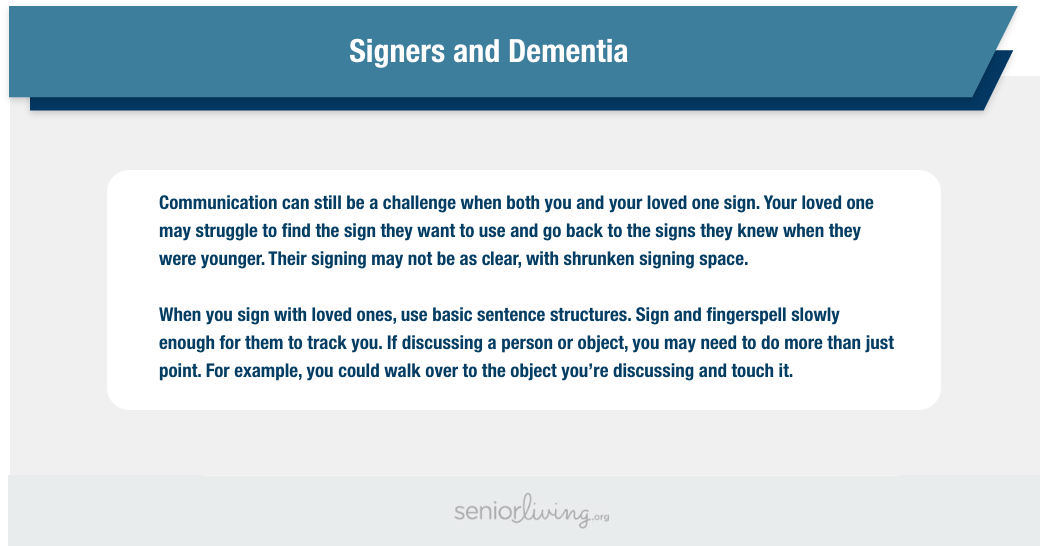

Communication Through Interpreters
If your loved one uses sign language, you're likely to have many experiences with interpreters. Some are paid professionals, while others are simply the family members who sign best. Follow a few guidelines regardless of who the interpreter is.
- Maintain eye contact even if your loved one is watching the interpreter.
- Use direct language (“How are you?” instead of “How is he today?”).
- Expect slight gaps between your spoken message and the interpreter's signed message.
- Expect the interpreter to occasionally ask you for clarification.
- Try to have just one person speak at a time (in group conversations).
If the interpreters are paid professionals, treat them as such. Don't engage them in personal conversation when they're on duty. Above all, treat their presence as neutral. Their job is to communicate messages, so if your loved one says something upsetting, don't take it out on the interpreter.
It can be natural for family members to serve as interpreters. Some people who are deaf prefer it that way, even if their family member isn't too skilled of a signer. Just remember that family member interpreters are not trained and might take longer to convey messages. They may also get messages wrong. Their biases could even creep into conversations, causing them to change words or withholding information they don't want the other party to know.
Bottom line: When sharing something important or sensitive, it may be best not to use a family member interpreter. If you do communicate through a family member, verify the message through an email or text.
It's natural to mess up once in a while with interpreters, especially if you're new to using them. Don't sweat these mistakes. Focus on getting communication right the next time.
Brain Breaks
Listening fatigue describes the toll that listening takes on the deaf brain. Even a 10-minute conversation could wear your deaf loved one out, depending on the person's abilities, experience, the complexity of the conversation, and the background noise present. Listening fatigue is incredibly common and is nothing you should take personally.
Concentration fatigue is similar, even affecting deaf people who don’t wear hearing aids or cochlear implants.6 For example, lip-reading takes a huge amount of focus and brainpower. Even watching an interpreter takes its toll. If you’ve experienced Zoom fatigue, you get an idea of what concentration fatigue from watching an interpreter is like.
When using interpreters, deaf people must constantly watch the interpreter. When they do glance out the window to give their eyes and brain a break, they miss information. Conversely, hearing people can doodle on notepads, gaze out windows to their heart’s content and otherwise balance their brain power load.
Anyway, what does all this mean when you communicate with loved ones who are deaf? Several things:
- Expect listening and concentration fatigue, especially the longer the event, the more people involved and the noisier the environment.
- Ask your loved ones how they deal with the fatigue and if there's anything you can do to help (like turn the TV off or give them 30 minutes to nap in your bedroom).
- It's normal if your loved one needs to take breaks throughout an event.
- Fatigue can prevent productive communication. If the 8 p.m. phone calls always get cut short, experiment with different times.
- If your loved one is in school, be especially aware of fatigue. Don't hold heavy-duty conversations right after classes if you can help it.
- Recent changes in hearing ability can greatly affect fatigue. Suppose your wife always wore hearing aids but recently got cochlear implants activated. Expect her to tire more quickly because her brain is working differently. Over time, her brain will adjust, but listening fatigue is likely to persist to some extent.
Safety Devices and Daily Living Aids for Hearing Loss
Communication with loved ones doesn't always mean conversations. Perhaps you just want to know that your senior citizen parents are OK or that your spouse is aware when the smoke alarm goes off.
Medical alert systems: Some medical alert systems feature loud beeping and easily visible flashing lights when users connect with emergency responders. That's good; otherwise, your loved one may spend too many scary moments wondering if their call attempt went through.
Check whether the medical alert system has a note on file that your loved one is deaf. The more details in the note, the better. Does your loved one communicate through signing, not speaking? Include that information. Does your loved one wear hearing aids most of the time? Include that detail.
When your family registers a medical alert system, you create an emergency response plan. It lists who the emergency operators call and at which points. Some users accidentally trigger false alarms and don't want emergency services showing up at their door every other week. Their plan may entail the operator calling them back in case it was a false alarm, and if there's no reply, contacting a family member to check on the user.
If your loved one is deaf, whether verbal or nonverbal, they (and your family) may prefer for operators to call emergency services right away. It saves confusion and can mean the difference between life and death. Other communication devices and systems to think about include:8
- Doorbell systems
- Phone ring alerts
- Baby cry signalers
- Wake-up alarms
- Smoke alerts
- Fire alarms
- Carbon monoxide alerts
- Weather alarms
- General hearing alert systems
A general hearing alert system is meant to cover everyday household occurrences such as crying babies, ringing doorbells, and ringing telephones. It can also incorporate open windows and beeping fire alarms. These systems vary in complexity but generally have a base unit that works with receivers set around the house. Some systems are mobile or even wearable.
Communicating with Loved Ones
Deafness doesn't have to be an obstacle for communicating with your loved ones, even if you're hosting a big wedding. Communication does get trickier with dementia, but whiteboards, Boogie Boards, and caregiver cards are among the tools that help.
Technologies such as Ava and voice-to-text recognition apps can save the day, but inclusive communication is mostly about the human element. It requires respect, patience, and flexibility. When there's a will, there's a way.
Additional Resources
Assistive Technology for the Deaf and Hard of Hearing: Alerting Systems, Assistive Listening Devices and More
Assistive Devices for People with Hearing, Voice, Speech, or Language Disorders: FM Systems, Touch Screens, and More
How to Help Older Relatives Use Video Calling during Coronavirus: It's All About Connection
Generations On Line: Simple Guides to Help Elderly Loved Ones When You Can't Be There in Person
References and Footnotes
- Tips for Communicating with the Deaf/Hard of Hearing: HSDC. (n.d.). Hearing, Speech & Deaf Center. Retrieved July 02, 2020, from https://www.hsdc.org/services/deaf-101/
- Features of Hearing Aid Technology. (n.d.). Washington University Physicians. Retrieved July 02, 2020
- Dementia and Sensory Loss: Hearing Loss. (n.d.). Social Care Institute for Excellence. Retrieved July 02, 2020, from https://www.scie.org.uk/dementia/living-with-dementia/sensory-loss/hearing-loss.asp
- Martin, B. (2017, March 08). Successful Hearing Aid Use, Part 6: When the Fitting Is Painful. Retrieved July 02, 2020, from https://hearinghealthmatters.org/hearinprivatepractice/2013/successful-hearing-aid-use-part-6-when-the-fitting-is-painful/
- Parfitt, E. (2016, August 11). What You Should Know about Concentration Fatigue. Hearing Like Me. Retrieved July 02, 2020, from https://www.hearinglikeme.com/why-you-should-know-about-concentration-fatigue/
- Fosslien, L., and Duffy, M.W. (2020, June 19). How to Combat Zoom Fatigue. Harvard Business Review. Retrieved July 02, 2020, from https://hbr.org/2020/04/how-to-combat-zoom-fatigue



